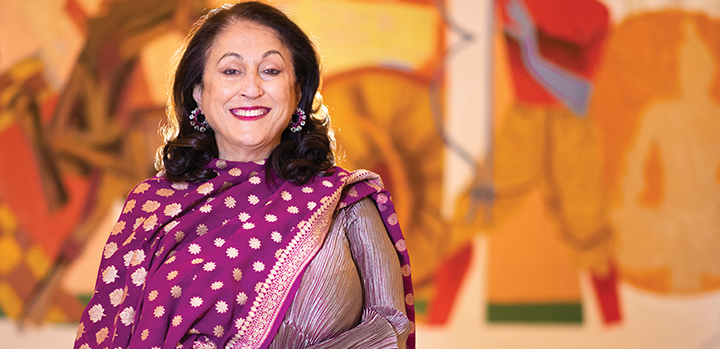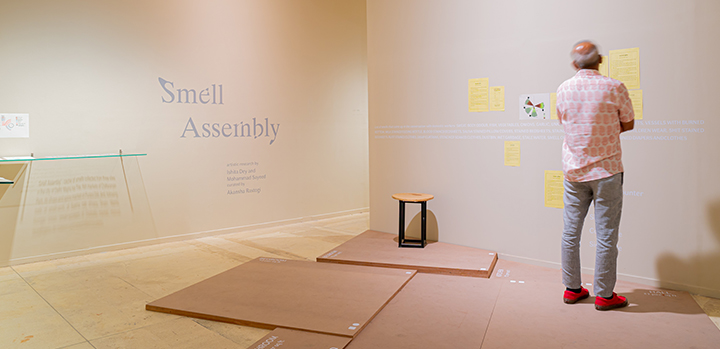Kiran Nadar Museum of Art is an endeavor to encourage artists of different genres, while also keeping in mind the expectation of art connoisseurs. Kiran Nadar, Founder and Chairperson of the Museum, speaks to Meera Srikant on how her collection started and the journey so far.

You may have repeated this several times, but please share with us the genesis of Kiran Nadar Museum of Art.
I began my own art collection when I was building my home. Then it grew and I had more work than I could display in my house. I started putting them in storage. I felt it was time to do something more meaningful. If I was going to continue to collect, then I must do it for some purpose and thought, why not take the art out into a public space where they could be showcased? That’s how the idea started. It took me five years to start, and now we have two spaces – one in Saket and one in Noida. But we are in the process of looking to construct a standalone building.
The art that I have collected have been given over to Kiran Nadar Museum of Art and we organize different exhibitions. In addition to my collection, we also take works from other collectors on loan. These shows are free of cost for anybody who wants to visit. We have different programmes to discuss art, we conduct workshops and other art-related events for the audience.
But we thought we needed a larger space more suited to displaying art and so we are in the process of building a structure that is as important as the collection on display.
What has been the response like?
It’s been ten years since we started our museum. It’s been a great exercise, showcasing Indian art, and we have had very good response to our shows. But one issue that we have in India is that the footfalls to any art project are not the greatest. Most people don’t have an interest in art. It’s probably education that is needed, and which we are doing that through programmes aimed at developing the sensibilities of the people to all kinds of art.
Please share some of the details of your programmes.
We are starting early, in the school level with the hope that it will permeate as the students grow older. Our footfalls have definitely gone up from the time we started to today. But to get value out of it, you have to run a lot of programmes.
I have a large collection of 6,000 works and my interest is with the moderns but today my collection has got all dimensions
How is the world of art evolving in India? Is there enough encouragement for artists to innovate?
Indian art is evolving, there is definite growth happening. However, it is not at the desired pace, which is because of lack of collectors. There isn’t focused collection happening in India. And, as a result, it’s difficult to bridge the gap. If you look at China, art is experiencing fantastic development. One, the artists are really supported and then museums came up. And the Chinese collectors collect Chinese art. So the Chinese market has grown tremendously in size. The same is not true for the Indian art market. It has not been as focused as China. So, we have a long way to go to reach that level. But we do have such artists and we do have different schools that are being built in India. Things should go up with all the efforts people are making to promote good art. It is important that the returns are also there.
How does KNMA provide encouragement and exposure to artists?
We show many artists such as Nasreen Mohamedi, Himmat Shah (to name a few) through individual retrospectives. We have organized retrospectives of various artists. So we do promote Indian artists and with that promotion, artists also get appreciation.
Please tell us a little bit about your collection and your preferences.
I have a large collection of 6,000 works and my interest is with the moderns but today my collection has got all dimensions. It is not unidimensional. I have all aspects of India art, including miniatures and Ravi Varma. It is more encompassing.
My collection is also growing. I am trying to collect in the areas where there are some gaps. There are some areas that are very representative and other areas which require some more work to be done. So I am trying to do that. But the collection will grow and artists will be shown.
How do you assess the value of an art and how it will appreciate?
If someone wants to invest in art, then they must first develop a sensibility by seeing a lot of art. They must hone their eye and then buy art that they like. Even if doesn’t appreciate, it should be something you will enjoy living with. The profit aspect, though important, shouldn’t be the primary reason. There definitely should be an element of wanting to have that work in your home because you feel it will be something you will appreciate and you hope that it will appreciate in value terms as well. Just monetary appreciation is not the only reason you should collect art.

We have a very rich art heritage in India – the palmyra tradition, the monuments like Khajuraho, miniature paintings from the Moguls – it’s a very rich fabric that we wear. Having a sensibility that looks at this rich heritage and how that can be nurtured in the current generation. Art can be a very important part in your development, especially for children. Families should treat going to museums as an event that will widen their horizons. Rather than just looking at going to the mall or going shopping, they can spend, let’s say, one day in a month in museum or visiting an exhibition. That, I think, is very important.
If someone wants to invest in art, then they must first develop a sensibility by seeing a lot of art. They must hone their eye and then buy art that they like. Even if doesn’t appreciate, it should be something you will enjoy living with. The profit aspect, though important, shouldn’t be the primary reason